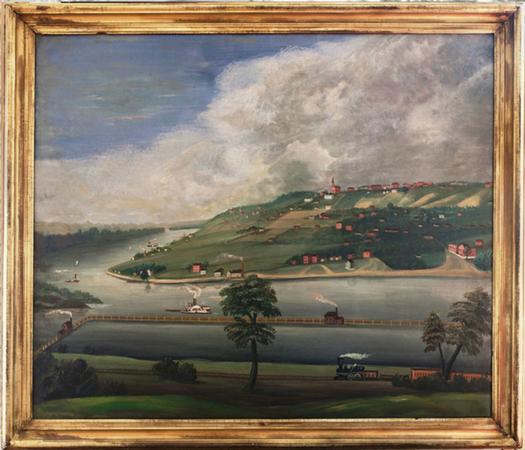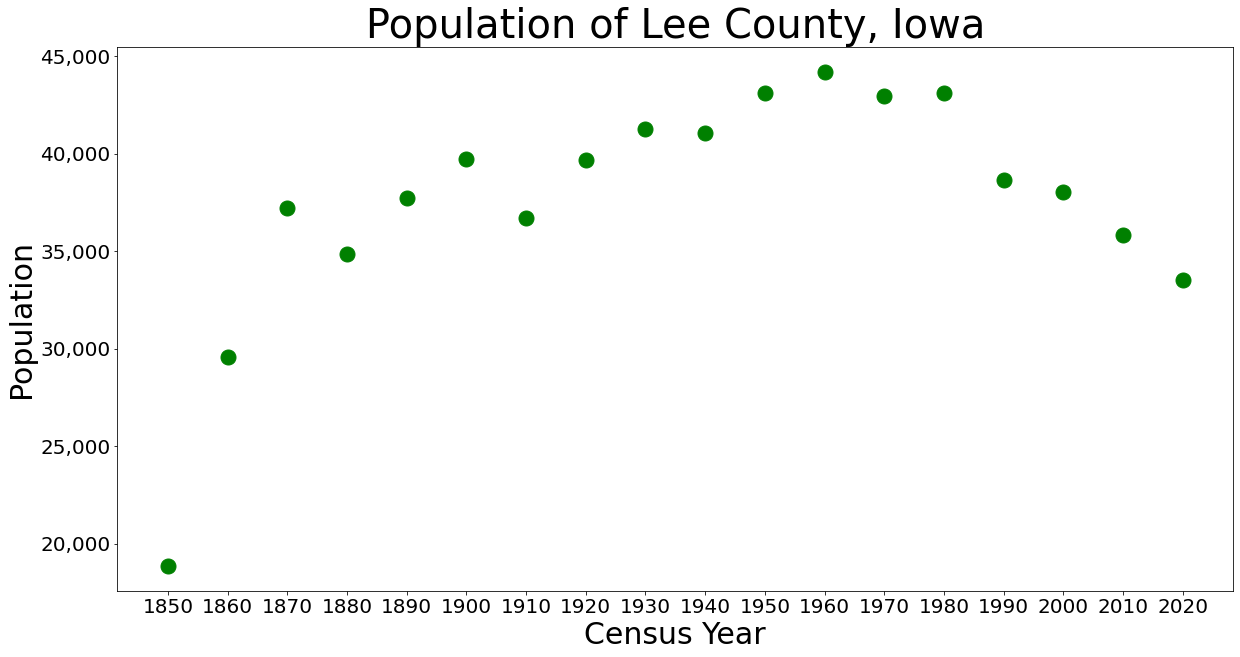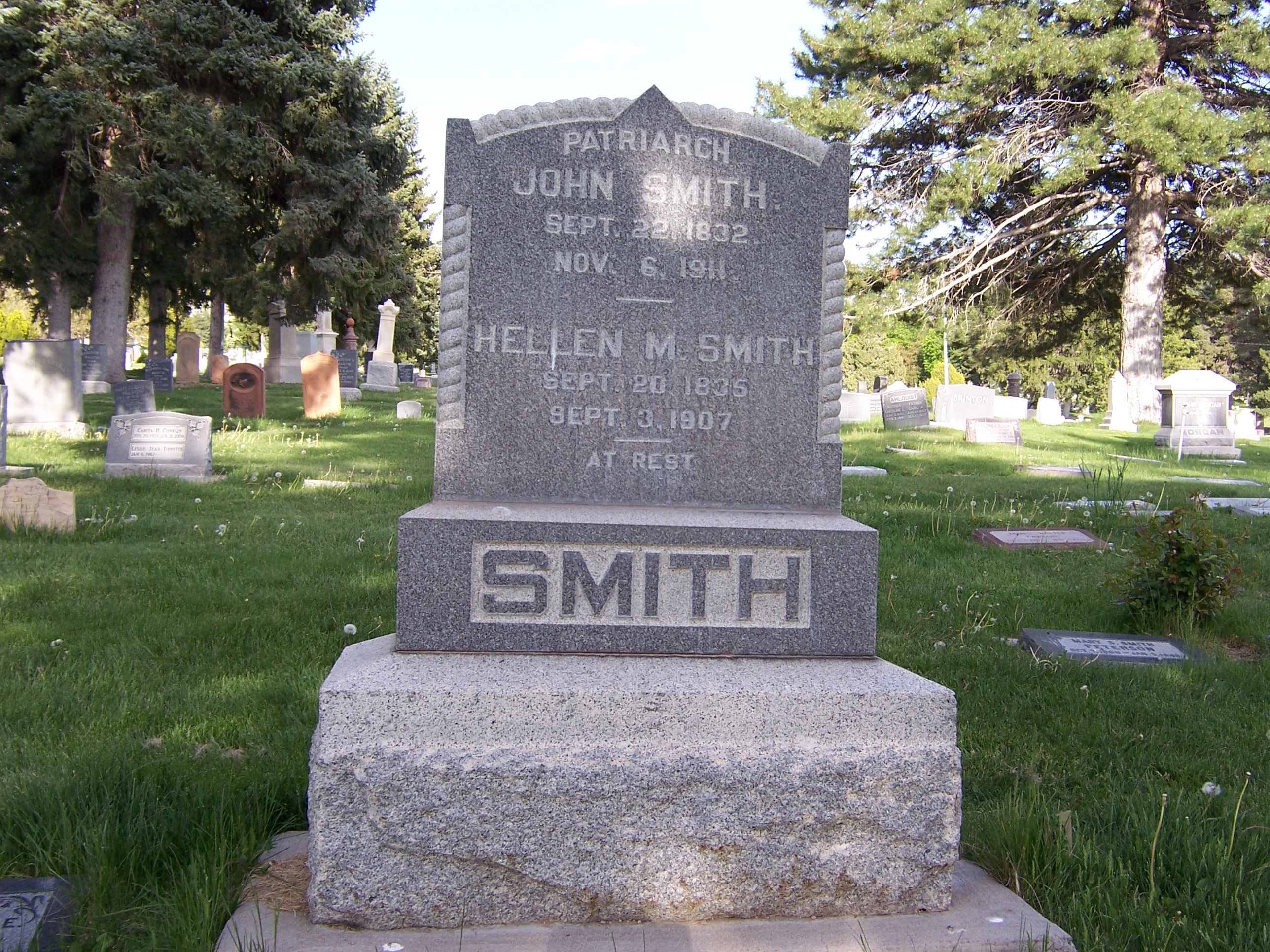|
John Smith (uncle Of Joseph Smith, Jr.)
John Smith (July 16, 1781 – May 23, 1854), known as Uncle John, was an early leader of the Church of Jesus Christ of Latter-day Saints (LDS Church). Smith was the younger brother of Joseph Smith Sr., uncle of Joseph Smith and Hyrum Smith, father of George A. Smith, grandfather of John Henry Smith, and great-grandfather of George Albert Smith. He served as a member of the first presiding high council in Kirtland, Ohio, as an assistant counselor in the First Presidency under Joseph Smith, and as presiding patriarch under Brigham Young. He was succeeded as presiding patriarch by his great nephew, who was also named John Smith. Smith served as president of the stake in Lee County, Iowa, during the Nauvoo period.He is the only person to serve as a stake president after being a member of the First Presidency. He was also the first president of the Salt Lake Stake, the first stake in Utah Territory, and as such was the leader of the Latter-day Saints in Utah in the winter of 1847� ... [...More Info...] [...Related Items...] OR: [Wikipedia] [Google] [Baidu] |
Derryfield, New Hampshire
Manchester is a city in Hillsborough County, New Hampshire, United States. It is the List of cities by population in New England, most populous city in New Hampshire. At the 2020 United States census, 2020 census, the city had a population of 115,644. Manchester is, along with Nashua, New Hampshire, Nashua, one of two county seat, seats of New Hampshire's most populous county, Hillsborough County. Manchester lies near the northern end of the Northeast megalopolis and straddles the banks of the Merrimack River. It was first named by the merchant and inventor Samuel Blodgett, namesake of Samuel Blodget Park and Blodget Street in the city's North End. His vision was to create a great industrial center similar to that of the original Manchester in England, which was the world's first industrialized city. History The native Pennacook people called Amoskeag Falls on the Merrimack River—the area that became the heart of Manchester—''Namaoskeag'', meaning "good fishing place". In ... [...More Info...] [...Related Items...] OR: [Wikipedia] [Google] [Baidu] |
George Albert Smith
George Albert Smith Sr. (April 4, 1870 – April 4, 1951) was an American religious leader who served as the eighth president of the Church of Jesus Christ of Latter-day Saints (LDS Church). Early life Born in Salt Lake City, Utah Territory, Smith was one of nineteen children of Latter Day Saint apostle John Henry Smith. His mother, Sarah Farr, was the first of John Henry Smith's two wives (who he had simultaneously for many years). His grandfather, for whom he was named, was also an LDS Church apostle as well as a cousin of church founder Joseph Smith. John Henry Smith and George Albert Smith are the only father and son pair to have been members of the Quorum of the Twelve at the same time, having served in the Quorum together between 1903 and 1910. In his youth, Smith worked at the Zions Cooperative Mercantile Institution (ZCMI) factory and traveled throughout Utah as a salesman. Smith attended high school at Brigham Young Academy, graduating in 1884. He then studied law ... [...More Info...] [...Related Items...] OR: [Wikipedia] [Google] [Baidu] |
Amasa Lyman
Amasa Mason Lyman (March 30, 1813 – February 4, 1877) was an early leader in the Latter Day Saint movement and was an apostle. He was also a counselor in the First Presidency to Joseph Smith. Early life and conversion Lyman was born in Lyman, New Hampshire, the third son of Roswell Lyman and Martha Mason. In the spring of 1832, Lyman met two traveling Latter Day Saint missionaries, Orson Pratt and Lyman E. Johnson. Lyman was baptized a member of the Church of Christ on April 27, 1832, by Johnson. On April 28, Lyman was confirmed by Pratt. After becoming a Latter Day Saint, Lyman traveled 370 miles to Palmyra, New York, where he hoped to meet Joseph Smith and Martin Harris. (Smith and Harris had lived in the Palmyra area when they published the Book of Mormon and organized the church in 1830). When Lyman arrived in Palmyra, he discovered that Smith and Harris had moved to Ohio the previous year, and that Smith was currently visiting Missouri. Determined to join the Latter Day ... [...More Info...] [...Related Items...] OR: [Wikipedia] [Google] [Baidu] |
Oliver Cowdery
Oliver H. P. Cowdery (October 3, 1806 – March 3, 1850) was an American Mormon leader who, with Joseph Smith, was an important participant in the formative period of the Latter Day Saint movement between 1829 and 1836. He was the first baptized Latter Day Saint, one of the Three Witnesses of the Book of Mormon's golden plates, one of the first Latter Day Saint apostles, and the Second Elder of the church. In 1838, as Assistant President of the Church, Cowdery resigned and was excommunicated on charges of denying the faith. Cowdery claimed Joseph Smith had been engaging in a sexual relationship with Fanny Alger, a teenage servant in his home. Cowdery became a Methodist, and then in 1848, he returned to the Latter Day Saint movement. Biography Early life Cowdery was born October 3, 1806, in Wells, Vermont. His father, William, a farmer, moved the family to Poultney in Rutland County, Vermont, when Cowdery was three. (Cowdery's mother Rebecca Fuller Cowdery died on September 3 ... [...More Info...] [...Related Items...] OR: [Wikipedia] [Google] [Baidu] |
Church Of Christ (Latter Day Saints)
The Church of Christ was the original name of the Latter Day Saint church founded by Joseph Smith. Organized informally in 1829 in New York and then formally on April 6, 1830, it was the first organization to implement the principles found in Smith's newly published Book of Mormon, and thus its establishment represents the formal beginning of the Latter Day Saint movement. Later names for this organization included the Church of the Latter Day Saints (by 1834 resolution),"Minutes of a Conference" '''', vol. 2, no. 20, p. 160 (May 1832). the Church of Jesus Christ, |
William Smith (Latter Day Saints)
William Smith (also found as William B. Smith) (March 13, 1811 – November 13, 1893) was a leader in the Latter Day Saint movement and one of the original members of the Quorum of the Twelve Apostles. Smith was the eighth child of Joseph Smith Sr. and Lucy Mack Smith and was a younger brother of Joseph Smith Jr., the founder of the Latter Day Saint movement. After the 1844 murders of Joseph and Hyrum Smith, William Smith claimed leadership of the Latter Day Saints and attracted a small number of followers. Most church members accepted Brigham Young as rightful leader of the church, and Smith was later affiliated with the Strangite and Reorganized Church of Jesus Christ of Latter Day Saints (now the Community of Christ). Early life Born in Royalton, Vermont, Smith and his family suffered considerable financial problems and moved several times in the New England area. He was living in the home of his parents near Manchester, New York, when his brother Joseph reported that he ... [...More Info...] [...Related Items...] OR: [Wikipedia] [Google] [Baidu] |
John Smith LDS Patriarch
John is a common English name and surname: * John (given name) * John (surname) John may also refer to: New Testament Works * Gospel of John, a title often shortened to John * First Epistle of John, often shortened to 1 John * Second Epistle of John, often shortened to 2 John * Third Epistle of John, often shortened to 3 John People * John the Baptist (died c. AD 30), regarded as a prophet and the forerunner of Jesus Christ * John the Apostle (lived c. AD 30), one of the twelve apostles of Jesus * John the Evangelist, assigned author of the Fourth Gospel, once identified with the Apostle * John of Patmos, also known as John the Divine or John the Revelator, the author of the Book of Revelation, once identified with the Apostle * John the Presbyter, a figure either identified with or distinguished from the Apostle, the Evangelist and John of Patmos Other people with the given name Religious figures * John, father of Andrew the Apostle and Saint Peter * Pope J ... [...More Info...] [...Related Items...] OR: [Wikipedia] [Google] [Baidu] |
Plural Marriage
Polygamy (called plural marriage by Latter-day Saints in the 19th century or the Principle by modern fundamentalist practitioners of polygamy) was practiced by leaders of the Church of Jesus Christ of Latter-day Saints (LDS Church) for more than half of the 19th century, and practiced publicly from 1852 to 1890 by between 20 and 30 percent of Latter-day Saint families. Today, various denominations of fundamentalist Mormonism continue to practice polygamy. The Latter-day Saints' practice of polygamy has been controversial, both within Western society and the LDS Church itself. The U.S. was both fascinated and horrified by the practice of polygamy, with the Republican platform at one time referencing "the twin relics of barbarism—polygamy and slavery." The private practice of polygamy was instituted in the 1830s by founder Joseph Smith. The public practice of plural marriage by the church was announced and defended in 1852 by a member of the Quorum of the Twelve Apostles, Orson ... [...More Info...] [...Related Items...] OR: [Wikipedia] [Google] [Baidu] |
Nauvoo, Illinois
Nauvoo ( ; from the ) is a small city in Hancock County, Illinois, United States, on the Mississippi River near Fort Madison, Iowa. The population of Nauvoo was 950 at the 2020 census. Nauvoo attracts visitors for its historic importance and its religious significance to members of several groups: The Church of Jesus Christ of Latter-day Saints; the Community of Christ, formerly the Reorganized Church of Jesus Christ of Latter Day Saints (RLDS); other groups stemming from the Latter Day Saint movement; and the Icarians. The city and its immediate surrounding area are listed on the National Register of Historic Places as the Nauvoo Historic District. History The area of Nauvoo was first called Quashquema, named in honor of the Native American chief who headed a Sauk and Fox settlement numbering nearly 500 lodges. By 1827, white settlers had built cabins in the area. By 1829 this area of Hancock County had grown sufficiently so that a post office was needed and in 1832 the t ... [...More Info...] [...Related Items...] OR: [Wikipedia] [Google] [Baidu] |
Lee County, Iowa
Lee County is the southernmost county in the U.S. state of Iowa. As of the 2020 census, the population was 33,555. The county seats are Fort Madison and Keokuk. Lee County is part of the Fort Madison–Keokuk, IA- IL- MO Micropolitan Statistical Area. History Fort Madison dates to the War of 1812. Lee County was the location of the Half-Breed Tract, established by treaty in 1824. Allocations of land were made to American Indian descendants of European fathers and Indian mothers at this tract. Originally the land was to be held in common. Some who had an allocation lived in cities, where they hoped to make better livings. Lee County as a named entity was formed on December 7, 1836, under the jurisdiction of Wisconsin Territory. It would become a part of Iowa Territory when it was formed on July 4, 1838. Large-scale European-American settlement in the area began in 1839, after Congress allowed owners to sell land individually. Members of the Church of Jesus Christ of Latt ... [...More Info...] [...Related Items...] OR: [Wikipedia] [Google] [Baidu] |
Stake President
A stake is an administrative unit composed of multiple congregations in certain denominations of the Latter Day Saint movement. The name "stake" derives from the Book of Isaiah: "enlarge the place of thy tent; stretch forth the curtains of thine habitation; spare not, lengthen thy cords, and strengthen thy stakes" (Isaiah 54:2). A stake is sometimes referred to as a stake of Zion. History The first Latter Day Saint stake was organized at church headquarters in Kirtland, Ohio, on February 17, 1834, with Joseph Smith as its president. The second stake was organized in Clay County, Missouri, later that year on July 3, with David Whitmer as president. The Missouri stake was relocated to Far West, Missouri, in 1836, and the Kirtland Stake dissolved in 1838. A stake was organized at Adam-ondi-Ahman in 1838 and abandoned later that year due to the events of the Mormon War. In 1839, the church's central stake was established at Nauvoo, Illinois, with William Marks as its president. Add ... [...More Info...] [...Related Items...] OR: [Wikipedia] [Google] [Baidu] |
John Smith (nephew Of Joseph Smith)
John Smith (September 22, 1832 – November 6, 1911), was the fifth Presiding Patriarch of the Church of Jesus Christ of Latter-day Saints (LDS Church). His father was Hyrum Smith, the older brother of Joseph Smith, the founder of Mormonism. Having served for 56 years, he was the longest serving Presiding Patriarch in the history of the LDS Church. Smith traveled west to Winter Quarters and then Salt Lake City with the Mormon pioneers. He traveled with Heber C. Kimball's party and his step-mother Mary Fielding Smith. Smith joined the "Battalion of Life Guards" to protect the Latter-day Saints from Native Americans. During his life, Smith maintained strong relationships with his family members in the Reorganized Church of Jesus Christ of Latter Day Saints (RLDS Church), particularly his cousin Joseph Smith III. Though John Smith was never released as Presiding Patriarch, some general authorities were outspoken in their disapproval of Smith's unwillingness to marry more than one p ... [...More Info...] [...Related Items...] OR: [Wikipedia] [Google] [Baidu] |




